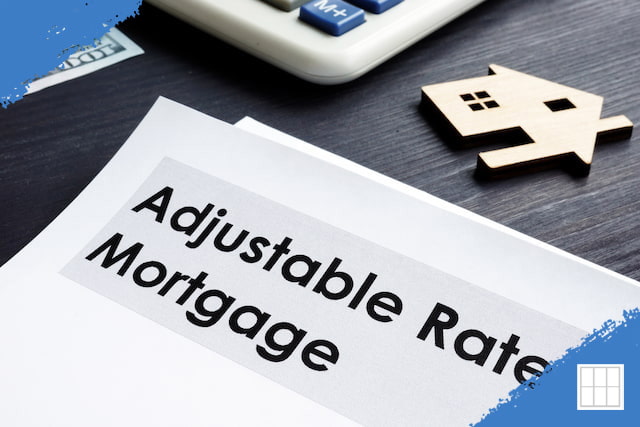When it comes to selecting a mortgage, homebuyers are often faced with a crucial decision…

Adjustable-rate mortgages: Learn the basics of ARMs
Mortgages have many options, but you can choose from fixed rates or ones that change. Fixed-rate loans lock in your interest rate and payment for life, while adjustable rate mortgages (ARMs) have fluctuating margins which could lead to savings if taken out at just the right time!
What is an adjustable-rate mortgage?
With adjustable-rate mortgages (ARM), you can enjoy low-interest rates for the first few years of your loan. After the initial fixed rate period ends, it’s possible to have higher or lower payments depending on market conditions at the time of purchase and investor confidence in general!
Interest rates can be unpredictable, although, in recent decades, they’ve trended downward. However, the current rates are trending higher. Though many people believe that this year’s increase is a sign of more increases ahead (and thus ARMs will become less popular), historically speaking, it remains low compared to other years.
Adjustable-rate mortgage vs. teaser rate
The initial interest rate on an variable-rate loans are sometimes called a “teaser” rate, and even ARMs themselves are referred to as ‘teasers.’ While they’re generally the same despite some differences, such as what type of home loan it might have been that offered these low introductory rates with dramatic increases or decreases.
How do ARMs work?
The 5/1 ARM is the most common variable-rate mortgage:
- The introductory rate of the 5/1 ARM lasts for the first five years; that’s the “5” in 5/1.
- After the introductory period, the interest rate can change every year; that’s the “1” in 5/1.)
Lenders typically offer terms of 3/1, 5/1, 7/1, and 10/1 ARMs.
The great thing about an ARM is that you are protected from steep year-to-year increases in monthly payments because of caps on rates and payment changes.
- A periodic rate cap limits how much the rate can change yearly.
- A lifetime rate cap limits the maximum amount the interest rate adjusts over the life of the loan.
- The payment cap limits the amount the monthly payment can increase, rather than how much the rate can change in percentage points. Payment caps are more common on a negatively amortizing loan.
Types of ARMs
- Hybrid ARM – This is a traditional adjustable-rate mortgage. The loan starts with an introductory fixed-rate period, usually for the first few years (usually one to 10). After this initial period, the rate adjusts based on the index’s average and margin sum, typically once per year.
- Interest-only ARM – Adjustable-rate mortgages, the borrower only pays interest (no principal) for a specific period. After the interest-only period, the borrower begins making principal and interest payments.
The initial interest-only period can be for as little as a month to a few years. The monthly payments are initially low since you are only paying interest. - Payment-option ARM – A payment-option adjustable-rate mortgage allows you to choose from several payment options. They include a traditional payment, which includes principal and interest. The payments can be based on a specified loan term, such as 15-, 30-, or 40- years.
An interest-only payment (which does not apply principal to the amount you owe). Or a minimum payment, which is less than the amount of interest due that month. This option is referred to as negative amortization – you do not pay the total interest due, which is added to the principal of the loan.
How variable mortgage rates on ARMs are determined
Most Adjustable Rate Mortgages (ARMs) are tied to one of the three major indexes:
- One-year Treasury bill – The yield that debt securities are paying, which issued by the United States Treasury .
- 11th District cost of funds index (COFI) – COFI is calculated using the sum of the monthly average interest rates for marketable Treasury bills and for marketable Treasury notes.
- Secured Overnight Financing Rate (SOFR) – SOFR has replaced the LIBOR – London Interbank Offered Rate as the benchmark rate for ARMs
The loan application paperwork should include an ARM disclosure statement that identifies the index, margin, and rate caps.
When an ARM rate changes, the mortgage lender takes the index rate and margin, called a fully indexed rate. The index can change, but the margin does not.
For example, let’s say your index is 1.5 percent, and the margin is 2.25 percent; they are added together for a fully indexed rate of 3.75 percent. If the index is 1.75 percent a year later, then the fully indexed rate on your loan will rise to 4.0 percent.
The Pros and cons of adjustable-rate – ARMs
Pro’s
- The initial rate translates to lower monthly payments and the potential to allocate more money toward the principal
- Interest rate and monthly payments might decrease
- The interest rate can’t increase beyond the cap limits
Con’s
- Interest rates and monthly payments can rise to an unaffordable level, even with the cap limits in place.
- A more complex loan structure that could be difficult to understand
Is an adjustable-rate mortgage right for you?
Variable interest rate mortgages provide a lower interest rate for the first years of your loan in trade for certainty. They’re generally not ideal if you plan to stay in your home long term. However, they are a good choice if you plan to keep the real estate for a shorter period or plan to refinance. If that suits your needs best, then it might be worth considering!
Key takeaways
- Adjustable-rate mortgages (ARMs) come with an interest rate that changes at predetermined times, such as once a year. The rate can go up or down depending on economic factors.
- ARMs typically have a low introductory rate, which translates to more affordable monthly mortgage payments initially.
- ARMs are generally better for borrowers who plan to stay in the home for a shorter time or expect to refinance before the introductory rate period ends.
Are you ready to apply for an adjustable loan?
Metropolitan Mortgage has been in business since 1997, and we have assisted many home buyers in the Midwest. If you are looking for an adjustable rate mortgage in Overland Park and the greater Kansas City metropolitan area, we can help. Metropolitan Mortgage offers mortgage programs in Kansas and Missouri.
Contact us if you have any mortgage-related questions or concerns. If you are ready to move forward, you can view rates, obtain a customized instant rate quote, or apply directly from our website


